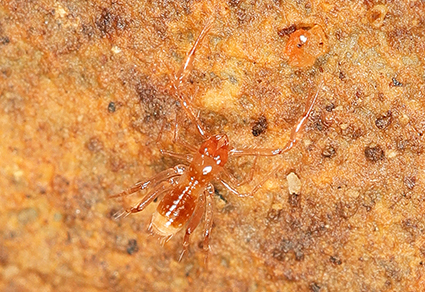Abstract
Eleven new Lagynochthonius species from twelve karst caves of eastern Yunnan are described, including detailed diagnosis and illustrations: L. crassus sp. nov. from Unnamed Cave 1 (Maguan County), L. fengi sp. nov. from Unnamed Cave 2 (Yanjin County), L. magnidentatus sp. nov. from Xiao Cave (Fuyuan County), L. minimus sp. nov. from Yanfen Cave and Cizhu Cave (Xichou County), L. retrorsus sp. nov. from Qinglong Cave (Daguan County), L. serratus sp. nov. from Unnamed Cave 3 (Malipo County), L. spinulentus sp. nov. from Yingshan Cave (Zhenxiong County), L. xiaolinensis sp. nov. from Dayan Cave (Zhenxiong County), L. xibaiensis sp. nov. from Hama Cave (Zhenxiong County), L. xinjiaoensis sp. nov. from Yueliang Cave (Fuyuan County), L. yaowangguensis sp. nov. from Unnamed Cave 4 (Malipo County). An identification key to all known Lagynochthonius species from China is also provided.
References
Beier, M. (1951) Die Pseudoscorpione Indochinas. Mémoires du Muséum National d’Histoire Naturelle, Paris, Nouvelle Série, 1, 47–123.
Chamberlin, J.C. (1931) The arachnid order Chelonethida. Stanford University Publications, University Series, Biological sciences, 7, 1–284.
Chamberlin, J.C. (1962) New and little-known false scorpions, principally from caves, belonging to the families Chthoniidae and Neobisiidae (Arachnida, Chelonethida). Bulletin of the American Museum of Natural History, 123, 303–352.
Cosgrove, J.G., Agnarsson, I., Harvey, M.S. & Binford, G.J. (2016) Pseudoscorpion diversity and distribution in the West Indies: sequence data confirm single island endemism for some clades, but not others. Journal of Arachnology, 44 (3), 257–271. https://doi.org/10.1636/R15-80.1
Edward, K.L. & Harvey, M.S. (2008) Short-range endemism in hypogean environments: the pseudoscorpion genera Tyrannochthonius and Lagynochthonius (Pseudoscorpiones: Chthoniidae) in the semiarid zone of Western Australia. Invertebrate Systematics, 22, 259–293. https://doi.org/10.1071/IS07025
Harms, D., Nentwig, W., Gloor, D. & Harvey, M.S. (2022) Introducing the World Arachnida Catalog: the new research environment for (almost all) arachnid orders. The Journal of Arachnology, 50 (1), 113–117. https://doi.org/10.1636/JoA-S-21-063
Harrison, S.E., Guzik, M.T., Harvey, M.S. & Austin, A.D. (2014) Molecular phylogenetic analysis of Western Australian troglobitic chthoniid pseudoscorpions (Pseudoscorpiones: Chthoniidae) points to multiple independent subterranean clades. Invertebrate Systematics, 28 (4), 386–400. https://doi.org/10.1071/IS14005
Harvey, M.S. (1989) Two new cavernicolous chthoniids from Australia, with notes on the generic placement of the south-western Pacific species attributed to the genera Paraliochthonius Beier and Morikawia Chamberlin (Pseudoscorpionida: Chthoniidae). Bulletin of the British Arachnological Society, 8, 21–29.
Harvey, M.S. (1991) Catalogue of the Pseudoscorpionida. Manchester University Press, Manchester and New York, vi + 726 pp.
Harvey, M.S. (1992) The phylogeny and classification of the Pseudoscorpionida (Chelicerata: Arachnida). Invertebrate Taxonomy, 6, 1373–1435. https://doi.org/10.1071/IT9921373
Hou, Y.M., Gao, Z.Z. & Zhang, F. (2022) Two new species of cave-adapted pseudoscorpions (Pseudoscorpiones, Chthoniidae) from Yunnan, China. ZooKeys, 1097, 65–83. https://doi.org/10.3897/zookeys.1097.82527
Howarth, F.G. (1980) The zoogeography of specialized cave animals: A bioclimatic model. Evolution, 34, 394–406.
Howarth, F.G. (1983) Ecology of cave arthropods. Annual Review of Entomology, 28, 365–389.
Huang, G.C., Tang, C.Y., Ding, L.X., Li, K., Cheng, X.B., Liu, A.S. & Liu, F. (2018) Fantastic and beautiful scenery–karst landform. Geology and Mineral Resources of South China, 34 (4), 369–373. [in Chinese] https://doi.org/10.3969/j.issn.1007-3701.2018.04.014
Johnson, J., Loria, S.F., Joseph, M.M., & Harms, D. (2022) Biogeographical and Diversification Analyses of Indian Pseudoscorpions Reveal the Western Ghats as Museums of Ancient Biodiversity. Molecular Phylogenetics and Evolution, 175, 107495. https://doi.org/10.1016/j.ympev.2022.107495
Judson, M.L.I. (2007) A new and endangered species of the pseudoscorpion genus Lagynochthonius from a cave in Vietnam, with notes on chelal morphology and the composition of the Tyrannochthoniini (Arachnida, Chelonethi, Chthoniidae). Zootaxa, 1627, 53–68. https://doi.org/10.11646/zootaxa.1627.1.4
Latella, L. (2019) Biodiversity: China. In: White, W.B., Culver, D.C. & Pipan, T. (Eds), Encyclopedia of Caves. 3rd Edition. Academic Press, Amsterdam, pp. 127–135. https://doi.org/10.1016/B978-0-12-814124-3.00016-9
Li, D.H. (2008) Adaptability characters of karst cave animals in dark environment. Sichuan Journal of Zoology, 27 (3), 340–343. [in Chinese]
Li, Y.C., Liu, H. & Shi, A.M. (2019) A new cave-dwelling species of Lagynochthonius (Arachnida: Pseudoscorpiones: Chthoniidae) from Yunnan Province, China. Zootaxa, 4571 (1), 28–34. https://doi.org/10.11646/zootaxa.4571.1.2
Mahnert, V. (1988) Une nouvelle espèce du genre Tyrannochthonius (Lagynochthonius) (Pseudoscorpiones, Chthoniidae) des grottes de Sarawak (Malaysia). Archives des Sciences, Genève, 41, 383–386.
Mahnert, V. (1997) New species and records of pseudoscorpions (Arachnida, Pseudoscorpiones) from the Canary Islands. Revue Suisse de Zoologie, 104, 559–585. https://doi.org/10.5962/ bhl.part.80011
Mahnert, V. (2011) A nature’s treasury: pseudoscorpion diversity of the Canary Islands, with the description of nine new species (Pseudoscorpiones, Chthoniidae, Cheiridiidae) and new records. Revista Ibérica de Aracnología, 19, 27–45.
Ming, Q.Z. (1997) Study on tourism resources exploitation of karst caves in Yunnan. Geography and Territorial Research, 13 (1), 33–36. [in Chinese]
Muchmore, W.B. (1991) Pseudoscorpions from Florida and the Caribbean area. 14. New species of Tyrannochthonius and Lagynochthonius from caves in Jamaica, with discussion of the genera (Chthoniidae). Florida Entomologist, 74, 110–121. https://doi.org/10.2307/3495247
Wang, Y. (2001) Study on explotation and utilization condition of karst groundwater in Yunnan Province. Journal of Hydraulic Engineering, 1, 49–52. [in Chinese]
Weygoldt, P. (1969) The biology of pseudoscorpions. Harvard University Press: Cambridge, Massachusetts, 145 pp.
World Pseudoscorpiones Catalog (2022) World Pseudoscorpiones Catalog. Natural History Museum Bern. Available from: https://wac.nmbe.ch/order/pseudoscorpiones/3 (accessed 21 September 2022)
Xu, H.R., Gao, Z.Z. & Zhang, F. (2022) Two new species of the pseudoscorpion subfamily Lamprochernetinae Beier, 1932 from Guizhou, China (Pseudoscorpiones: Chernetidae). Zootaxa, 5105 (4), 581–592. https://doi.org/10.11646/zootaxa.5105.4.7
Zhang, C., Feng, Z.G. & Zhang, F. (2020) Two new cave-dwelling pseudoscorpions (Pseudoscorpiones: Neobisiidae: Parobisium) from Yunnan, China. Zootaxa, 4834 (1), 107–120. https://doi.org/10.11646/zootaxa.4834.1.7


